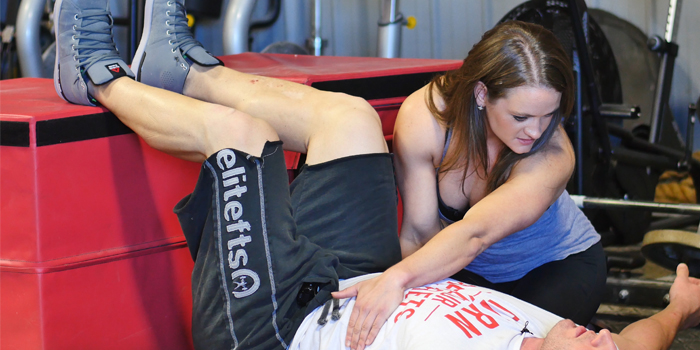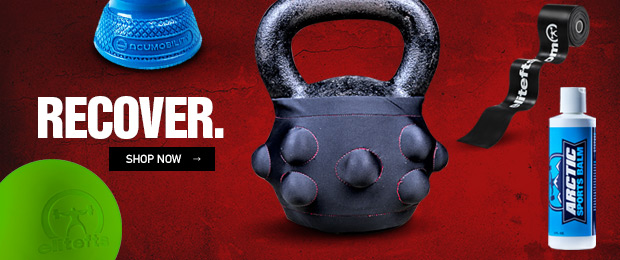
“Neat party trick, Dani.”
Really though, I’m tired of the two camps of “voodoo” diaphragmatic talk (e.g., IT FIXES EVERYTHING!) and the “put-my-head-in-the-sand-and-all-it-does-is-influence-the-lower-ribs” talk. Acknowledge its power without becoming married to it.
If we want to help people, we have got to stop picking camps. I took the videos below, totally off the cuff and at the spur of the moment because as much as we use the word “systems” (neuromuscular, endocrine, central nervous), we still think about them in isolation.
RECENT: The Most Underutilized Kettlebell Excercise You Should Be Doing
I’m tired of seeing physios or docs who have never actually pushed themselves to slap research papers against each other because they fail to put two and two together and are stuck in one camp and marrying themselves to hand-picked RCTs instead of putting the client first.
Ignoring systemic interplay, to me, is the equivalent of Dave’s pet peeve of being negligent enough to not do a needs analysis. How the hell are you going to get someone (better, faster, stronger, “anti-breakage”) enough if you’re so myopic that you see our system from one, maybe two, facets? It’s not enough to call thinking about recovery “thorough.” It’s an expectation, and we can do better.
In less than four minutes, this individual and I addressed the following:
- The mechanical role of the diaphragm.
- Mechanical advantage of core musculature in creating a pillar.
- Chemical changes in blood pH and blood chemistry that directly influence the state of our physiology. For all the talk about neurotransmitter and blood chemistry optimization that’s become en-vogue, we’re awfully quick to forget the easiest way to alter those things.
- The proprioceptive stability requirements and how those demands are met and seen partially in lat length and tonic changes, seen here two days after a heavy workout.
- Mechanical joint position, especially in regards to shoulder rotation (if you watch the video closely, you can see where I hit the first resistance in shoulder rotation is relatively close to where I hit the second resistance, and his shoulder blade tips forward with an osseous rather than capsular or soft tissue end feel).
- The state of the central nervous system. Teaching someone to “get parasympathetic post-training” isn’t enough. It’s a good start, but our positions and postures play a huge role in whether or not we can stay there.
- “Bracing ability.” This was noted after the camera was off, but the client said at point-blank, “Oh my god, I had no idea how much air I was putting in my chest instead of into my pillar.” Three days later, he took a previous 2RM and hit it for a set of six with three in the tank.
Four minutes. Is this list comprehensive? Absolutely not. Does this client give a crap that we influenced all of that? Depends on the client, but you need to figure out what they care about and also think about their best, whether or not they know it.
We have access to all of that via the ribcage and breathwork. This is more than open and closed scissor. This is more than sympathetic and parasympathetic. This is access to systems (PLURAL). This is your client’s health and ability to feel good, move well — all the things they entrust us to help them with.
I have been heavily influenced by the folks over at the Postural Restoration Institute (I had some serious exposure to their principles starting in 2009), so while I may be a little biased, it’s been absolutely incredible to watch some of the changes and increased awareness of some of the principles of respiration on both a chemical and a mechanical level. There are about as many schools of thought regarding respiration’s effects on mechanical changes as there are ways to skin a cat, from PRI to RPR and DNS, to more holistic-type treatments, including meditation and yoga.
Breathing in and of itself gets put in a box that isolates it to something we do every day. True.
It also has an incredible chemical (e.g., recovery, how our body systems function, what our CNS responds to; not like that’s a big deal or anything) AND mechanical influence. I’m not here to sit and debate what method is best, but I’m here to tell YOU, as a coach, athlete, trainer, whatever, to wake the hell up and start seeing things with a new lens.
When you start to see coaches in the NBA, NHL, and MLB have holy shit moments that change how they see their athletes for years after their initial exposure (meaning it’s not just a new shiny toy but has lasting influence), I hate to say it, but you, trying to squat a PR for a meet, aren’t too good for these ideas, and writing them off is your own choice. I want to repackage some of this information for you in a way that makes sense because it is one of the most powerful tools you can have in your toolbox.
We talk about the ribcage all the time. Literally. I can’t get on social media without someone talking fixing their rib flare or keeping ribcage controlled in an overhead position or using the open versus closed scissor position. Most of the time, we talk about the ribcage from the perspective of a proper brace to ensure stability, pressure, and power production. Those are all true, good things to be focused on. There’s a long list of additional benefits that influence a number of systems.
If you want true change, influencing systems is the way to go. What breathwork permits us is access to systems, deep neural networks that are partially rooted in reflex. Reflexes are neuromuscular (like a knee jerk) or physiological. What you need to know is that they’re there, whether you acknowledge them or not, and highly integrated into our daily functioning. Some of the systems influenced include:
- Sympathetic and Parasympathetic Reflex Arcs: This is more than getting out of fight or flight — it’s finding an optimal state of arousal that permits optimal physiologic functioning (digestive, hormonal) with optimal mental and emotional functioning. There are more layers to this than social media promotes.
- Musculoskeletal: Most notably through the orientation of the ribcage and the pelvis, which directly or indirectly (in the case of the shoulder, via the scapulothoracic joint) influence rotational ability. Ordinarily, I’d spend a little more time working through some of the ribcage positional changes, and I’d really like to see greater change in shoulder rotation than what we saw in the video. Often, though, I’ll see influences in shoulder and hip rotation shape knee and elbow health. It’s not uncommon for me to see a change in rotational ability (and ball/socket congruence) to influence soft tissue health, especially labral, as well.
- Respiratory: Without getting too nerdy on breathing mechanics, yes, bracing should be easy, and we make it harder than it should be. It’s also the thing I see people jack up more than almost anything without realizing it. Our ability to utilize our lung volume appropriately plays a HUGE role in bracing and where we can put our air. Changes in blood pH via a mismatch in oxygen/carbon dioxide concentration can also play a role in shifting a lot for the autonomic reflexes mentioned earlier.
Is this the only way to influence systems? Hell, no. The intent of this article was to hopefully get you to think differently about how and why we approach things the way they do. When we hear the same things over and over, they lose their potency. The influence of the diaphragm on systemic changes shouldn’t be watered down, but all the misinformation and guru-ness of things… has.
READ MORE: Death to the Belly Breath
I’ll leave you with the idea that whether or not you believe that the respiratory system can be used to influence chemical changes, musculoskeletal changes, and central nervous system changes and has no bearing on things like the chemoreceptors in your carotid bodies. At some point, your beliefs don’t matter to your chemistry (neurology, endocrinology, etc.).
I struggle discussing these topics in articles because there is SO much available information out there, so I’ve done my best to give a small scope of an easy tool you can use to create pretty massive change for clients. It’s difficult to get into a lot of the in-depth mechanics of how, why, how to implement, etc., in the scope of these articles, especially from the perspective of joint mobility and soft tissue length, which I tend to be more interested in if I’m being honest.
I am always available and enthusiastic for some dialogue, so please don’t hesitate to reach out to me at Dani@MergePerformancePT.com or hop on my site, MergePerformancePT.com, to schedule a free discovery call if you’d like to chat.










